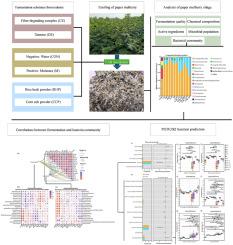造纸桑树青贮的系统优化:利用酶和工业副产物组成的工程副干酪乳杆菌-植物干酪乳杆菌联合体,实现稳定的生物质保存
IF 5.8
2区 生物学
Q1 AGRICULTURAL ENGINEERING
引用次数: 0
摘要
不可预测的天然微生物群落导致桑树青贮发酵不理想,导致蛋白质降解和氨排放增加,限制了其作为稳定生物质资源的效用。设计了一种配方乳酸菌(LAB)联合体(植物乳杆菌和副干酪乳杆菌的比例为2:1)来代替自然发酵。通过比较工业副产物(糖蜜,M;稻壳粉,RHP;玉米芯粉,CCP)和酶(纤维分解酶,CE;单宁酶,DE)与LAB对纸桑青贮发酵品质、化学组成和细菌群落的组合效应,进一步优化该策略。结果表明:与未处理青贮相比,各添加剂均降低了青贮的pH值,降低了氨氮/总氮比(AN/TN)和抗营养单宁,提高了有益类黄酮含量(CON)。细菌群落分析表明,与对照组相比,乳酸杆菌在青贮菌群中的相对丰度显著增加。这种微生物群落工程与发酵优势相关:显著降低pH和AN/TN比。使用PICRUSt2的功能预测表明,LAB治疗,特别是糖蜜(LAB_M),特别是上调碳水化合物代谢途径(“果糖和甘露糖代谢”,“半乳糖代谢”)。与RHP和CCP相比,乳酸菌与CE、DE或M的协同整合显著提高了纤维降解(减少了中性洗涤纤维,M除外),并保留了更多的粗蛋白质和淀粉。本研究表明,定向LAB工程是稳定桑树生物量的有效生物工程策略。此外,LAB具有更广泛的适用性,有可能提高不同原料来源的生物质转化效率。本文章由计算机程序翻译,如有差异,请以英文原文为准。

Systematic optimization of paper mulberry silage: Engineered Lacticaseibacillus paracasei-Lactiplantibacillus plantarum consortium with enzymes and industrial by-products for stable biomass preservation
Unpredictable natural microbial communities drive suboptimal fermentation in paper mulberry (Broussonetia papyrifera) silage, resulting in protein degradation and elevated ammonia emissions, limiting its utility as a stable biomass resource. A formulated lactic acid bacteria (LAB) consortium (Lactiplantibacillus plantarum and Lacticaseibacillus paracasei at 2:1 ratio) was engineered to replace spontaneous fermentation. This strategy is further optimized by comparing the combination effects of industrial by-products (molasses, M; rice husk powder, RHP; corn cob powder, CCP) and enzymes (fibrolytic enzymes, CE; tannase, DE) with LAB on the fermentation quality, chemical composition, and bacterial community of paper mulberry silage. Results showed that all additives lowered pH values, reduced ammonia nitrogen/total nitrogen ratio (AN/TN) and anti-nutritional tannins, while increasing the beneficial flavonoid contents compared to untreated silage (CON). Bacterial community analysis revealed that the LAB was successfully established, significantly increasing the relative abundance of Lacticaseibacillus within the silage microbiome compared to CON. This microbial community engineering correlated with superior fermentation: a significantly lower pH and reduced AN/TN ratio. Functional prediction using PICRUSt2 indicated LAB treatment, particularly with molasses (LAB_M), specifically upregulated carbohydrate metabolism pathways (‘Fructose and mannose metabolism’, ‘Galactose metabolism’). Synergistic integration of the LAB with CE, DE, or M significantly enhanced fiber degradation (reduced neutral detergent fiber, except for M), and preserved more crude protein and starch than RHP and CCP. This study establishes that targeted LAB engineering constitutes an effective bioengineering strategy for stabilizing paper mulberry biomass. Furthermore, the LAB has broader applicability, potentially enhancing biomass conversion efficiency across diverse feedstock sources.
求助全文
通过发布文献求助,成功后即可免费获取论文全文。
去求助
来源期刊

Biomass & Bioenergy
工程技术-能源与燃料
CiteScore
11.50
自引率
3.30%
发文量
258
审稿时长
60 days
期刊介绍:
Biomass & Bioenergy is an international journal publishing original research papers and short communications, review articles and case studies on biological resources, chemical and biological processes, and biomass products for new renewable sources of energy and materials.
The scope of the journal extends to the environmental, management and economic aspects of biomass and bioenergy.
Key areas covered by the journal:
• Biomass: sources, energy crop production processes, genetic improvements, composition. Please note that research on these biomass subjects must be linked directly to bioenergy generation.
• Biological Residues: residues/rests from agricultural production, forestry and plantations (palm, sugar etc), processing industries, and municipal sources (MSW). Papers on the use of biomass residues through innovative processes/technological novelty and/or consideration of feedstock/system sustainability (or unsustainability) are welcomed. However waste treatment processes and pollution control or mitigation which are only tangentially related to bioenergy are not in the scope of the journal, as they are more suited to publications in the environmental arena. Papers that describe conventional waste streams (ie well described in existing literature) that do not empirically address ''new'' added value from the process are not suitable for submission to the journal.
• Bioenergy Processes: fermentations, thermochemical conversions, liquid and gaseous fuels, and petrochemical substitutes
• Bioenergy Utilization: direct combustion, gasification, electricity production, chemical processes, and by-product remediation
• Biomass and the Environment: carbon cycle, the net energy efficiency of bioenergy systems, assessment of sustainability, and biodiversity issues.
 求助内容:
求助内容: 应助结果提醒方式:
应助结果提醒方式:


